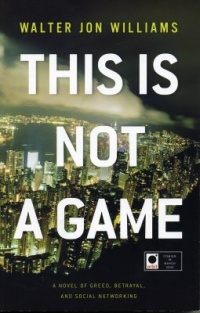 This Is Not A Game (2009) by Walter Jon Williams is a novel that blurs the lines between gaming and reality and explores the possible interaction between the two, given the fact that games continue to become more complex and better able to simulate reality, and can involve large networks of online participants. Williams looks at some of the unanticipated ways reality might intrude into a game, as well as the potential for a game and/or its players to affect the real world. It is against this conceptual backdrop that the particular events of the story unfold — riots, financial crises, murders — and in that context that their root causes are to be found. Although set in the very near future, as indicated by a few minor technological innovations, the novel comes across more like a contemporary techno-thriller than as science fiction — which is neither here nor there, I suppose. It is what it is, and it’s an enjoyable enough story with plenty of drama. The book is not without a few plot deficiencies here and there; still, it manages to grapple with some intriguing ideas that are worth thinking about, and so on balance I’d have to call it a success.
This Is Not A Game (2009) by Walter Jon Williams is a novel that blurs the lines between gaming and reality and explores the possible interaction between the two, given the fact that games continue to become more complex and better able to simulate reality, and can involve large networks of online participants. Williams looks at some of the unanticipated ways reality might intrude into a game, as well as the potential for a game and/or its players to affect the real world. It is against this conceptual backdrop that the particular events of the story unfold — riots, financial crises, murders — and in that context that their root causes are to be found. Although set in the very near future, as indicated by a few minor technological innovations, the novel comes across more like a contemporary techno-thriller than as science fiction — which is neither here nor there, I suppose. It is what it is, and it’s an enjoyable enough story with plenty of drama. The book is not without a few plot deficiencies here and there; still, it manages to grapple with some intriguing ideas that are worth thinking about, and so on balance I’d have to call it a success.
Dagmar Shaw is a “puppetmaster,” a game designer specializing in Alternate Reality Games. An ARG is something like a MMORPG mixed with a LARP, requiring online interaction and puzzle-solving interspersed with real-world events and missions. It can involve any and every type of medium: email, secret websites, fake documents, phone calls, text messages, live gatherings at special locations, packages in the mail, and so on — whatever the devious puppetmaster can work into the game to make it exciting and challenging. Dagmar is good at what she does, and her games are popular.
However, she soon finds herself the victim of circumstances that are all too real, forcing her to realize that, indeed, “this is not a game.” On her way home from the successful conclusion of a game event in Asia, Dagmar gets stranded for a time in Jakarta as Indonesia’s currency fails, leading to rioting and chaos. When she finally gets out of that mess and gets back to L.A., more bad luck awaits as one of her oldest friends from her college gaming days is murdered, apparently by the Russian maffia. Dagmar’s boss, also an old friend, is acting strange, asking her to make bizarre changes to her newest game, and giving no explanations. Still another old gaming friend also comes into the picture, reminding Dagmar of a seemingly innocuous quirk from a game years in the past, one that just might have relevance to current events. There are more murders, and all the while the currencies of various countries seem to be under some kind of mysterious attack.
Amid all this chaos, Dagmar hits on the idea of harnessing the millions of players of her current game to track down her friend’s killer, drawing on the multiplicity of skills and knowledge bound to be found in such a large group. She refers to this concept as the Group Mind. (Vernor Vinge, in Rainbows End, also invoked this idea of the problem-solving potential of large online groups.) And so Dagmar writes the murder into her game, turning her players into a vast force of detectives. But she gets more than she bargained for, as the Group Mind turns up much more than just the identity of a killer. It also uncovers information bearing on all the other mysteries occurring lately, allowing Dagmar to piece together the shocking truth.
The biggest weakness I saw with the book involved a certain crucial software/malware issue and the proposed solution. It seems to me that the solution was rather obvious and could have been implemented years earlier, thus eliminating this issue before it ever became a problem. I suppose it might be said that previously the problem had not become serious enough to need a solution; but I still think the writing was on the wall, and the relevant character realistically should/would have acted sooner. Other weak points were relatively minor but still noticeable, such as the hired mercenaries who are too laughably incompetent to pull off a simple rescue but yet can re-task a satellite as easily as the agents in 24. Or the hotel patrons in rioting Jakarta who look out the windows to see people jumping to their deaths off the roof of a neighboring hotel that was set on fire, but don’t seem worried enough to leave their own hotel. These kinds of little glitches give the novel a slightly disjointed, unrealistic feeling of weirdness that is a bit distracting.
As I said, though, the book presents some ideas worth contemplating. Just what kinds of problems could a large interactive online community — a Group Mind — solve, and how could it be effectively, and appropriately, harnessed? If you were part of such a group, how would you know if the game’s designers were using you for their own ends or not, or if those ends were legitimate? How can you tell if everything in a game is actually fictional? What happens when gamers take successful strategies for conquering the game world and apply them to the real world — what kind of mischief could they cause? Where should the line (if any) be drawn between games and reality, and is it a line that is worth maintaining?
If those sound like interesting questions, then I’d say you’ll get some enjoyment from this novel.















Ive never read any of this author’s long works. The critics seem to like him plenty, and I have had nothing but good experiences with his shorter stuff, but none of it looks very good to me sitting on the shelf.